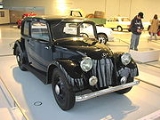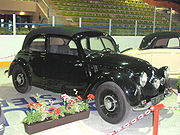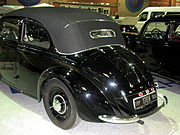
Rear-Engine Mercedes-Benz
Encyclopedia

From 1931 to 1939, Daimler-Benz AG produced three cars (Mercedes-Benz
Mercedes-Benz
Mercedes-Benz is a German manufacturer of automobiles, buses, coaches, and trucks. Mercedes-Benz is a division of its parent company, Daimler AG...
130, 150 and 170 H) with rear engine
Rear-engine design
In automobile design, a rear-engine design layout places the engine at the rear of the vehicle. The center of gravity of the engine itself is past the rear axle...
as well as a few prototypes. The production numbers remained quite low for each of these models, especially compared to the production of classical front-engine Mercedes cars.
Development and prototypes (W17/W25D)
At the beginning of the 1930s, inspired by the modern streamlined shape, there were attempts to move the engines from the forward compartment to the rear of the car. Such a move allows to decrease the volume of the front compartment. At the same time, the voluminous rear provides a lot of space above and behind the rear axle. Moreover, when fitted on the drive axle shaft were eliminated. The most famous such development was with the TatraTatra (car)
Tatra is a vehicle manufacturer in Kopřivnice, Czech Republic. The company was founded in 1850 as Schustala & Company later renamed Nesselsdorfer Wagenbau-Fabriksgesellschaft, a wagon and carriage manufacturer, and in 1897 produced the first motor car in central Europe, the Präsident. In 1918, it...
cars under the leadership of Hans Ledwinka
Hans Ledwinka
Hans Ledwinka was an Austrian automobile designer.- Youth :Ledwinka was born was born in Klosterneuburg , near Vienna, then part of the Austro-Hungarian Empire....
.
In 1930, Daimler-Benz AG entrusted Hans Nibel with the development of a small rear engine car based on the same principles. In 1931 the type W17 or 120 was created, a four-seat, equipped with two doors, vertical front and rear wheels and a four-cylinder boxer engine in the rear, with a displacement of 1200 cc and a power of 25 hp (18.4 kW). There were also attempts to row across built four-cylinder engines. In 1933 Mercedes built a vehicle with a front similar to the VW Beetle
Volkswagen Beetle
The Volkswagen Type 1, widely known as the Volkswagen Beetle or Volkswagen Bug, is an economy car produced by the German auto maker Volkswagen from 1938 until 2003...
later and a far extensive tail. The front wheel of the type W25 D or 175 is slanted or tilted backwards, in the middle of the tail fin attached hood divides the oval rear window, so it anticipated the small oval two piece rear window of the Beetles known as "pretzel form". The "D" referred to the three-cylinder diesel engine OM 134 with an output of 30 hp (22 kW), but due to high noise level, this vehicle was again rejected. From this type, 12 test cars were assembled
Mercedes-Benz 130 (W23)

The car was sold as a sedan, an open-top sedan or a convertible (with and without cabrio cover and without side windows), each being fitted with two doors. Due to its extreme unbalance (⅔ of the mass on the rear axle), the car had a very awkward handling. Because of the low sales volume, the model was discontinued in 1936.
Mercedes-Benz 150 (W30)
The Mercedes-Benz 150 was derived in 1935 from the 130 with only two seats and a more powerful engine, with 1498 cm³ and a power of 55 PS (40 kW). The top speed of the car was 125 km/h.The car was only offered as a Sport Roadster. The gas tank, which in the case of the Mercedes-Benz 130 was installed over the engine, was transferred to the front compartment, and therefore there was no room for luggage there. The practicality of the 150 was therefore very limited, and the price of the car was quite high at 6600 RM ; as a comparison the Mercedes-Benz 170 V had a price of 5500 RM. The car was discontinued in 1936 due to poor sales.
Mercedes-Benz 170 H (W28)


The car was significantly more expensive than the 170 V (two-door sedan 170 V - 3750 RM, 170 H - 4350 RM) and had much less room in the trunk, a much louder engine and a bad handling — better however than the one of the 130 - to offer. It was however more comfortable equipped and was therefore considered as a "finer" car, but sold much less than the 170 V. Apart from the sedan, there was still a convertible sedan as well. Production stopped in 1939 due to the War and the low demand.
Forty years later a company spokesman suggested that the car's relative lack of commercial success was caused by the rear mounting of the engine and the resulting absence of the "characteristic Mercedes-Benz tall radiator". The same spokesman was at pains to highlight the similarity of the car's overall architecture and some of its detailing to that of the later highly successful Volkswagen Beetle: it was pointed out that Dr Porsche
Ferdinand Porsche
Ferdinand Porsche was an Austrian automotive engineer and honorary Doctor of Engineering. He is best known for creating the first hybrid vehicle , the Volkswagen Beetle, and the Mercedes-Benz SS/SSK, as well as the first of many Porsche automobiles...
, creator of the Volkswagen, had been chief engineer at Daimler-Benz
Daimler-Benz
Daimler-Benz AG was a German manufacturer of automobiles, motor vehicles, and internal combustion engines; founded in 1926. An Agreement of Mutual Interest - which was valid until year 2000 - was signed on 1 May 1924 between Karl Benz's Benz & Cie., and Daimler Motoren Gesellschaft, which had...
between 1923 and 1932 when the little rear-engined Mercedes-Benz sedans were under development.
Because these cars, unlike front engined sister models, were not widely used, and also not suitable for conversion to wood gas generator
Wood gas generator
A wood gas generator is a gasification unit which converts timber or charcoal into wood gas, a syngas consisting of atmospheric nitrogen, carbon monoxide, hydrogen, traces of methane, and other gases, which - after cooling and filtering - can then be used to power an internal combustion engine or...
, they were not confiscated by the Wehrmacht. Therefore an above-average number of models survived in private hands without damage due to the war, but most were used to exhaustion in the early post-war years. Today, these cars remain among the rarest and most sought-after Mercedes-Benz models.
Sources
The source of this article is :- Oswald, Werner: Mercedes-Benz Personenwagen 1886-1986, Motorbuch-Verlag Stuttgart 1987, ISBN 3613011336
External Links
- "Tube Forms Auto Chassis and Cools Motor" Popular Science, August 1935 small article on the Model 130

